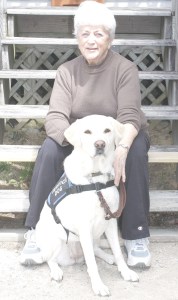BETHEL — A guide dog may retire, but it never ceases being a guide dog.
Pat Carter of Bethel has learned that since adopting 8-year-old retiree Sunny, who formerly served as Lynn Mason-Courtney’s guide dog.
Sunny was attacked by another dog and could no longer work.
Mason-Courtney said Sunny’s next person “had to be someone very special,” to understand that Sunny’s training would never leave her.
“I’ve known her (Sunny) quite a few years,” Carter said, so the steps leading to adopting her about 18 months ago “evolved.”
For Carter and her husband, Ted, Sunny “has taught us a great deal,” she said. “She wants to go everywhere with you — and she always walks on the left.”
Guide dogs are taught to lead a blind or visually-impaired person from the left.
“She’s part of your body,” Carter said.
Carter observed that Sunny is very intelligent and curious.
“She picks up on everything,” she said.
Sunny had to get used to having a man around all the time, after primarily being around women.
Adjusting to occasionally being left home alone was difficult for a dog trained to watch over someone 24/7. When Carter had to take a relative for a medical procedure and was gone all day, she came home to an upset canine.
“She sulked,” Carter said. “She would turn her head away.”
Another adjustment has been going outside on her own.
“It took a while before she wanted to venture anywhere from the house on her own,” Carter said. “Now she will walk on the property, and a little into the woods, and dig a little (which they are trained not to do). She’s learning a new life.”
A good part of that new life is adopting a chair next to the kitchen so she can keep an eye on everything, including food preparation.
“She doesn’t miss a thing,” Carter said. “She’s a chowhound.”
On encountering guide dogs and their ‘people’
For a blind or visually impaired person just learning to navigate with a new guide dog, streets and sidewalks and buildings can be a challenge.
It can also be a challenge for the sighted people who encounter them.
Two Bethel women who have guide dogs recently offered some tips and insights into their world, in order to help area residents who may encounter them.
Ann Nicholson lost her sight completely when she was 30. She first got a seeing eye dog six years later. But getting a dog does not relieve the person of responsibilities, she said.
“You need your own skills first,” said Nicholson, in order to be able to work efficiently with a dog.
For example, the person needs to be able to identify by sound the traffic patterns – when one line of cars starts up and another stops – at an intersection before crossing safely with a guide dog.
A common question from sighted people, she said, is whether the dog can distinguish red from green lights.
That’s not how it works. “The dog does what it is asked to do,” she said.
As dog and person work together to cross a street, said Lynn Mason-Courtney, who is visually impaired, drivers will sometimes call out their window, “It’s safe, you can go now.”
Though well-meaning, she said, it’s not helpful. She usually responds, “Thanks, I have to do it myself.”
Another driver habit that can confuse the person and the dog is honking the horn. It’s uncertain what the horn means – it could mean to go ahead or it could be a warning that the car is close by, Nicholson said.
Another bit of helpful knowledge she shared is that guide dogs should not be patted while in harness.
If a dog lover approaches and tries or asks to pat Fairest, her current dog, Nicholson will either say, “My dog is working so it’s distracting,” or she will have her sit and she will take the harness off, a signal to the dog that she’s “off-duty” and may enjoy the attention.
A large safety issue – which Mason-Courtney has unfortunately encountered multiple times over the years – is a dog running loose that attacks a guide dog. Mason-Courney has had several dogs retired (and one put to sleep) because of injuries or trauma that prevented them from continuing to work after the attack.
Traffic and pedestrian safety aside, the women also offered pointers on interacting with a blind person generally.
It’s okay to offer assistance, such as a guiding elbow – just be accepting regardless of whether the answer is “yes,” or “no, thanks,” said Nicholson. And, she said, “It’s our responsibility to tell someone how to help.”
Nicholson said blind people can take classes themselves on how to ask for help from others, “and get what you need.”
She also noted with some humor that when she approaches a group of people who are talking, they often stop talking.
“Don’t stop talking,” she said, “because now I can’t tell where you are!”

Comments are no longer available on this story